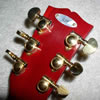
Gibson Les Paul Late 70’s/Early 80’s “Pre-Reissues”: On the Road to ’59?
By Mike Slubowski
Many articles have been written about how
guitarists and dealers in the mid to late 70’s and early 80’s
were asking Gibson to build a Les Paul that more closely conformed to
’59 specs. An excellent overview of the history of Les Pauls from
the 70’s through the 90’s was written by Walter Carter a few
years ago entitled “Keeping the Flame Alive” and is posted
on the Gibson website at: http://www.gibson.com/magazines/amplifier/1999/1/amptest.html
The following is not an attempt to rehash Walter’s excellent documentary, but rather to provide an overview pictorial of some of these “pre-59 reissue” guitars with some narrative and details of their construction and features based on the author’s experience in collecting and playing these guitars. It is ironic to note that, at a time in which Gibson was going through great strife with declining sales and profit margins, rivalries between the new Nashville plant and the Kalamazoo plant, and the downsizing and eventual closure of the Kalamazoo plant by 1984, the company was able to experiment and respond to purchasers’ requests for guitars that more closely emulated the beloved Les Paul Standard of 1959 - even though some of these attempts were way off the mark!








































